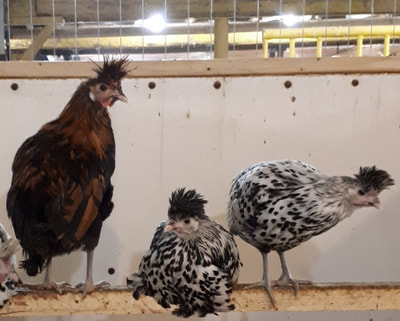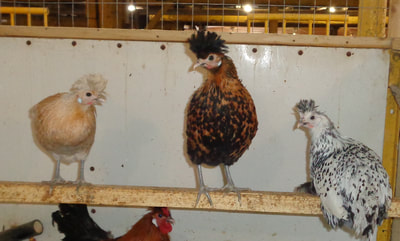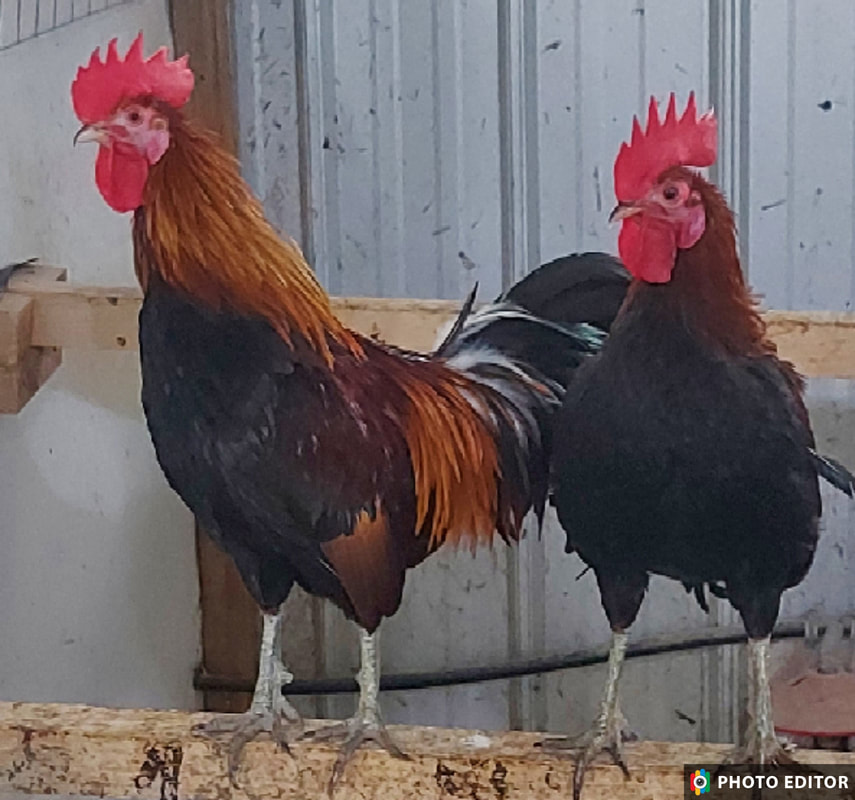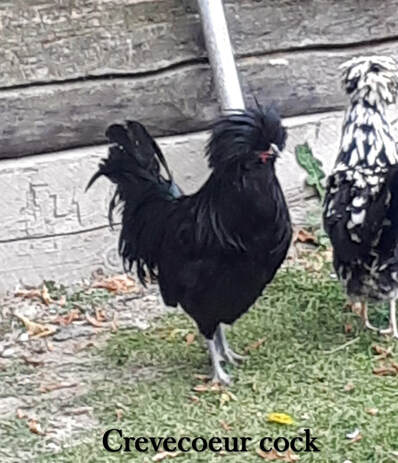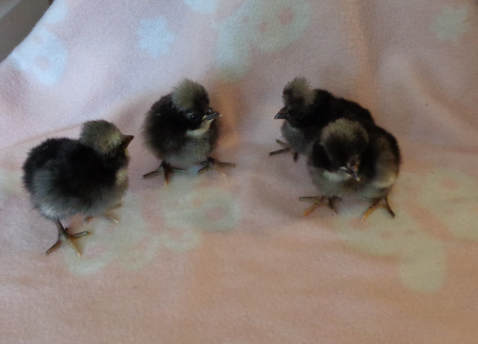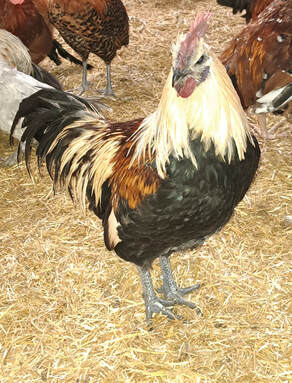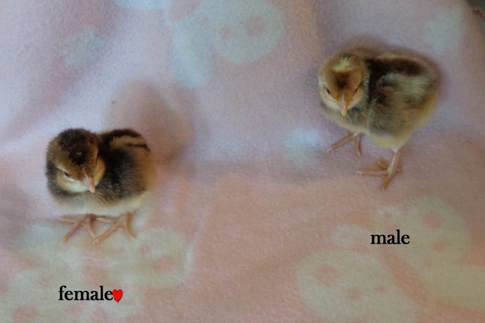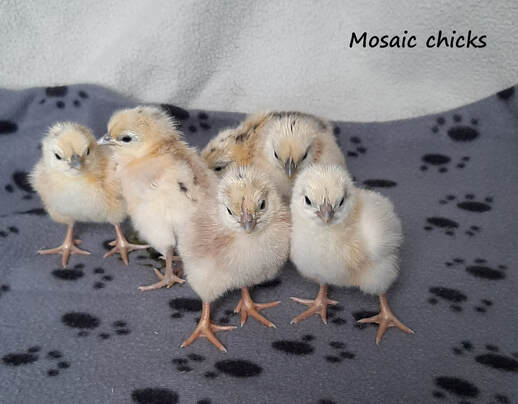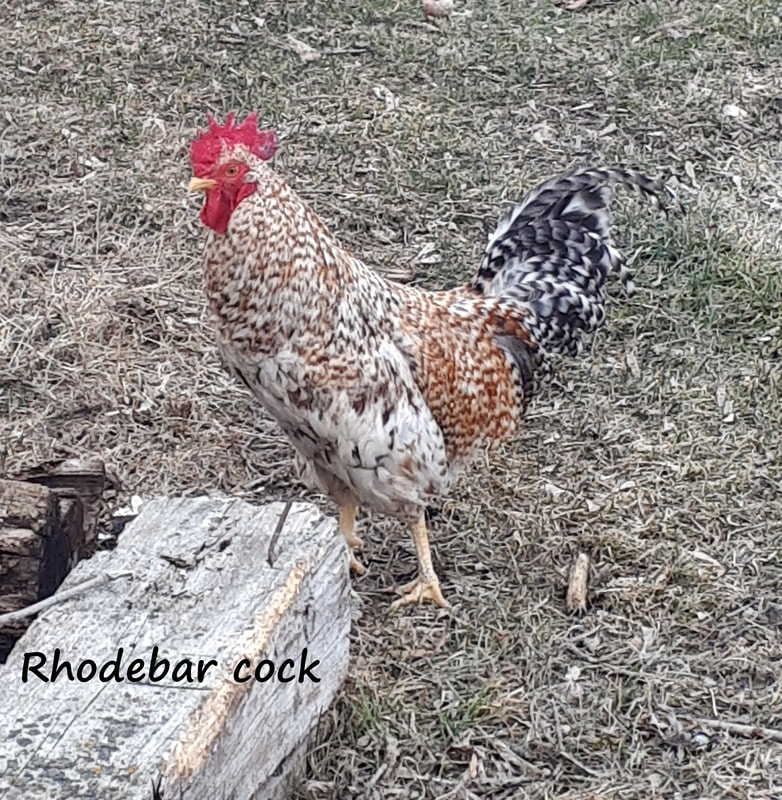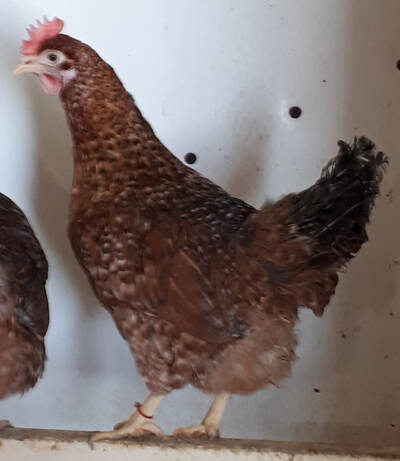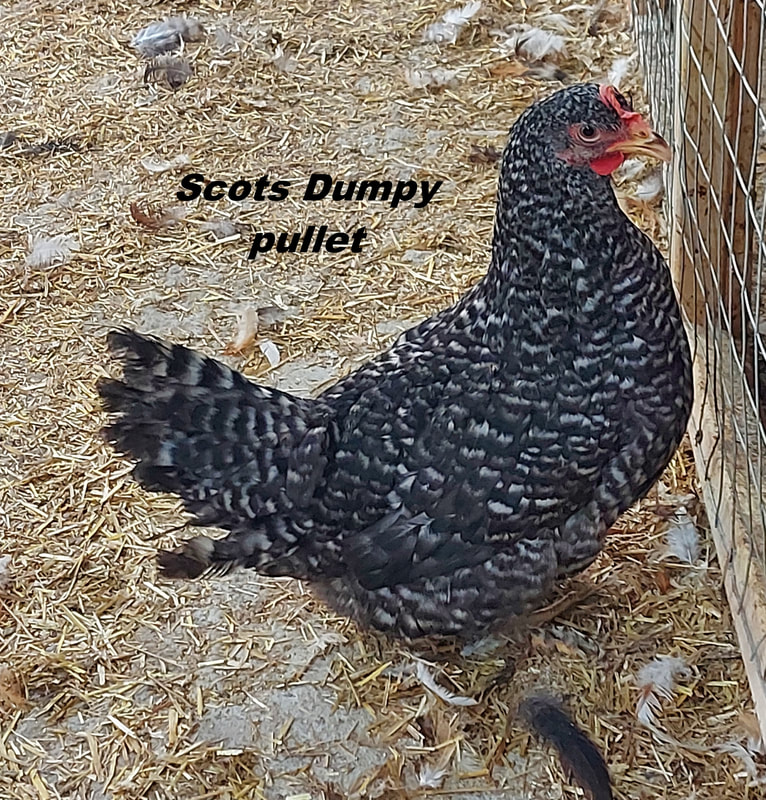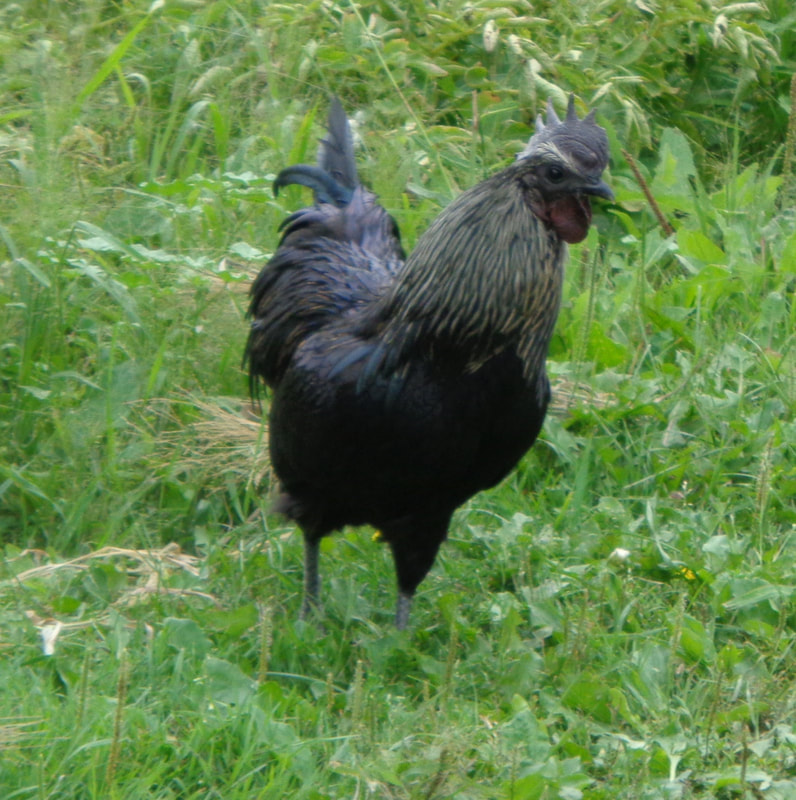Altsteirer

Description: The ancient Altsteirer hen is a very hardy bird. Laying very well about 200 plus large sized eggs. Eggs are white to tinted in color. Small crest with single comb and hens have a slight S curve in their comb. They are cold hardy and mature early. They originate in Austria and are one of the oldest breeds in Europe, dating back to the 13th century. We carry the partridge color.
Conservation status: Considered Endangered
Conservation status: Considered Endangered
Appenzellar - Spitzhauben

Spitzhauben- meaning pointed hat. Active birds that will forage for most of their food and are very cold hardy. Hens are good layers of approx 280 eggs per year of medium sized white eggs & will occasionally go broody if undisturbed. Their crest should point forward. They originated in the Appenzell canton region of Switzerland and thought to have been developed in the local monasteries. They are Switzerland's national bird. They come in 5 colors. We carry the silver spangled and gold spangled running together.
Conservation status: Threatened
Conservation status: Threatened
Appenzeller - Barthuhner

Barthuhner- meaning bearded hen. Active breed but not flighty and Is fairly calm. Is suited for free range and is a good forager and lay a large number of eggs approx 220 per year on little feed while being able to withstand harsh winters. Eggs are cream colored. Can be broody.They originated in North-eastern Appenzell canton region of Switzerland in a remote village of Wolfhalden. Developed in the late 1800's by Lord Zust of Appenzell. they come in 4 colors. We carry the black red.
Extremely rare, Practically unknown
SOLD OUT
Extremely rare, Practically unknown
SOLD OUT
Ayam Cemani

Ayam Cermani is quite possibly the rarest chicken in the world. They come from a village named Kedu, located in central Java, Indonesia. They are sometimes called Ayam Kedu after their village of origin. Ayam means chicken in Indonesian and Cemani means completely black in Javanese. The Cemani is a completely black chicken inside and out, meaning skin, meat, feathers, feet, comb, and even inside their months are black and some say even their blood is black. The cause of the chickens blackness is a genetic condition known as fibromelanosis. This gene, which is caused by a mutation that affects how pigment-producing cells work. This gene is also found in other black fowl breeds.
In their native Indonesia they are used for meat and eggs and are also considered a sacred animal and highly valued. They are believed to bring good fortune and their black meat will cure disease, so a lot of scarifies have lowered their numbers to only 3500 left in existence, making them incredibly rare and expensive, also know a the Lamborghini chicken.
Cemani’s are friendly, likable, very gentle and docile, not flighty or skittish. The breed weigh’s 3-5kg. They are winter hardy and lay approx 80 whitish with a slight pink tint eggs per year.
Breeders in North America are working very hard and culling strongly to try and keep the birds as black as possible but even with 2 pure black parent birds some chicks will have a few white wing tips, chest, and toes. Some will have color leakage with white or grey mouths, called oyster mouth and even silver chicks. This is because the gene that gives the black coloring is a recessive gene.
We will be breeding Indonesia Raven line for 2018. ( Parent stock of our birds came from Indonesia)
In their native Indonesia they are used for meat and eggs and are also considered a sacred animal and highly valued. They are believed to bring good fortune and their black meat will cure disease, so a lot of scarifies have lowered their numbers to only 3500 left in existence, making them incredibly rare and expensive, also know a the Lamborghini chicken.
Cemani’s are friendly, likable, very gentle and docile, not flighty or skittish. The breed weigh’s 3-5kg. They are winter hardy and lay approx 80 whitish with a slight pink tint eggs per year.
Breeders in North America are working very hard and culling strongly to try and keep the birds as black as possible but even with 2 pure black parent birds some chicks will have a few white wing tips, chest, and toes. Some will have color leakage with white or grey mouths, called oyster mouth and even silver chicks. This is because the gene that gives the black coloring is a recessive gene.
We will be breeding Indonesia Raven line for 2018. ( Parent stock of our birds came from Indonesia)
Ayam Ketawa
|
Ayam Ketawa or ‘laughing chicken’ is a breed originating from the area of Sidenreng Rappang in South Sulawesi, Indonesia. It belongs to a group of chickens known as Long Crowers. They are prized for the clarity and unusual length of their crows. The Ketawa’s crow has a similarity to a human laugh. The breed was originally held as a status symbol of the Buginese royal family but has entered into higher popularity in recent times since the fall of the monarchy which has now allowed the people of Indonesia ownership of this magnificent breed. Today it is still a symbol of courage, social status and heroism. They compete in contests for the most perfect crow, for the Governor of Sulawesi Cup. Ayam Ketawa means Laughing chicken and some other names for the breed are Ayam Gaga, in Buginese it is called Manu’ Gaga or just Gaga’ which means Stammering chicken. There are 3 types of Singing Styles the roosters can make dangdut [slow], gretek [fast] slow and disco. The reason that we are now allowed to have these birds is that the Indonesian Government is now promoting and encouraging the trading of the breed because it has become very rare and endangered, at one time it could only be owned by the royal family of Bugis Makasar. Roosters have a single red comb, wattles and earlobes. Legs color also tends to be green but can be different colors. They weigh approx. 6 lbs and hens 4 lbs. They can handle the heat but good shelter is needed in cold climates. Hens lay a light cream to white egg and they average about 90 eggs per year. Hens will go broody. They are docile, friendly and bear confinement well but love room to fly. The laughing chicken comes in variety of colors. They are a standard fowl.
|
Bielefelder

Description: They have been called the uber chicken. Due to their many desirable features, such as dual purpose and auto- sexing chicks. Roosters have a weight of 10-12 pounds and hens lay approx 200 eggs per year. they are very docile and welcome human interaction. This breed came from the Bielefeld region of East Westphalia Germany. During the 1970's Gerd Roth produced this good table bird. They are crele in color.
Breda

Description: An impressive bird with a tall proud confident stance with a regal movement. They are a large chicken this makes it a good meat bird. They produce medium sized white to cream colored eggs. They are calm, easy to handle and care for. They are not competitive. They have a head shaped like a crested tassel, it lacks a comb and has large shell nostrils that look like a crow. They also have feathered feet. They are good winter layers but poor sitters. Their name translated form Dutch means Crow head. they come from France, but some say they emanated from Dutch breeds. We carry Blue. Black & splash.
SOLD OUT for 2024
SOLD OUT for 2024
Bresse - Canadian or ( Canadian Gauloise )
|
Description: They are good for eggs as well as meat. Laying upwards of 250 eggs per year. They lay large size cream colored eggs. They are white with a have bright red single combs and blue steel legs. They weigh is about 5-7lbs. the Bresse is known to be able to have a marbling effect like beef during their growing. This makes them have a more intense flavor.
also known as Valaille de Bresse which has A.O.C. appellation d'origine controlee status. in its home region of France. Which became a breed approx 500 years ago in the Burgundy region of France. Bresse chickens were first imported to the US in 2011. They are call American or Canadian Bresse because of the import restrictions. Bresse chickens can cost $150-$200 Us dollars in France. They command a high premium over other poultry of the region. They come in 4 colors white, black, blue & splash. We carry all the colors. White in one group and the BBS in another. |
Crevecoeur

This breed originates In France. Their name means broken heart. One of the oldest french breeds. It is a dual purpose bird weighing 7-9 pounds. Unique horned comb. Tolerant to confinement. They are active & curious, fairly good layers of large white eggs and don't go broody. They are now very rare world wide.
Conservation status: Critical
SOLD OUT for 2024
Conservation status: Critical
SOLD OUT for 2024
Westfalische Totleger {Deathlayer}

Deahtlayer’s are a landrace breed originating in the region of Westphalia, Germany in the 18th century. Rural farmer’s started to notice a line of poultry that was remarkably productive for the time. The name was once Dauerleger in Low German which meant permanent layer, The name did not entirely reflect the birds production so it was changed to Totleger which means, Tot- meaning dead and leger meaning layer and Westaflische means from Westphalia, so the current official name is “Westfalische Totleger”. Which turns out to be the hens incredible ability to lay a large amount of medium white eggs. They will lay well into their old age as most hens stop at 4-5. Deathlayers can live 10-12 years. They are still rare even in Germany. Roosters weigh approx 5 lbs and hens 3.5 lbs. They have a small tight Rose comb close to the head which makes them good for cold weather. They also have totally black eyes. They are very active and a bit nervous breed as most white egg layer are. The breed almost went extinct in the 1980’s and is still quite rare today. The breed was originally prized for it’s excellent production, foraging instincts and ability to tolerate the foreboding climate of the Ravensberg foothills about 90 miles from the Swiss Alps. A recent German Census reports roughly only 1,500 Deahtlayer chickens left in Germany. As chicks they a very fragile. Their Plumage is tight to keep out drafts which forms a beautiful dignified bird. They come in Silver or Gold Penciled. We carry both colors running together
Erminette

The breed originated in the West Indies and was noted for exhibiting beautiful feathered coloration. They were first brought to America in the 1860’s. The breed was considered extinct in the 50’s and 60’s. Ron Nelson a renowned poultry breeder was driving in Wisconsin one day and noticed a flock of chickens near the roadside that resembled the old extinct Erminette’s. He went to the house and an elderly lady said yes, they were Erminette’s and had once belonged to her grandfather and he had passed them on to her father, who in turn passed them on to her. He took some eggs and hatched them and started to restore the breed. The breed is predominately white with some solid black feather’s, there is also a white and solid red feathered variety. The breed is a large dual purpose bird, clean legged and mostly single combed and has a general build that resembles closely the Plymouth Rock. They are not totally perfected, but are historical. They are gentle, and they lay a large white/ cream egg. They have good egg production, laying approx. 180 eggs per year and will go broody. They are cold hardy and forage well. It is not a true breeding color, (like the Blue Gene) crossing two Erminette colored birds will also give white and black birds. so you will get Erminette, white and black chicks.
New for 2022 Red Erminette. the Reds are a project color so you can hatch, red erminette, white , solid red, bk erminette and solid black.
New for 2022 Red Erminette. the Reds are a project color so you can hatch, red erminette, white , solid red, bk erminette and solid black.
Flarry Eye Grey
|
When making Gamefowl most breeders start by crossing established breeds but the origin and the history of Ned Glaven’s Flarry Eyed Fowl presents quite the opposite picture and for ½ a century there has not been any infusion of any other bloodline. So to relate to a strain that has remained for itself for so long is an honor. Ned Glaven brought the Flarry’s with him from Ireland when he came to the US more than 50 years ago. They are one of the most gorgeous game birds. Roosters are very protective of their flock. The birds are heavy boned weighing approx 5-6 lbs. The males have a grey tassel and single comb [that is usually dubbed], They have short tight feathering with a black breast. Flarry [fiery] red eyes and blue legs. Grey hackle turns to a combination of grey and red-rust on the saddle with black wings with an overcast of grey and red in the centre with duckwing tips. The hen is typically a dull color with a deep red chest, the body is a mixture of grey and brown with grey striped neck, the hen is considered a medium layer of cream colored eggs, laying 3-5 eggs per week which is great for a gamebird. She does go broody and make’s a great mother. The Flarry’s are great foragers and have self preservation instincts, never far from cover, always staying close together. Flarry’s are cold tolerant and are considered Ornamental. It is illegal to use them for game fighting. They are friendly towards people and very intelligent. Some reports say they are flighty but others say they are clam. The breed is not very common and hard to find.
|
Hedemora

The Hedemora is a native Swedish breed developed over 500 years ago in the surrounding area of Hedemora. It may be the most cold hardy chicken in the world. The breed was near extinction but rescued in the 1980’s. There are probably between one thousand and two thousand of these birds remaining worldwide. Hedemora’s were imported in the U.S.A. in 2010. This is a medium sized bird weighing 5 lbs for roosters and 4 lbs for hens. They are friendly, docile and easy to handle. They have a small red comb to prevent frostbite. The breed was use for egg production and is considered a prolific layer of 150 brown eggs per year, which is excellent considering they do this in the frigid cold. Hens routinely lay eggs though out the frigid winters, laying eggs in temperatures of -15 c. They will also forage in the snow in sub-zero weather for hours. Only about half of the hens will go broody but the ones that do make good protective mothers. The Hedemora’s have three different feather types Silkied {called Woolys}, Smooth feathered legged and Smooth clean legged. They all have a unique layer of down under their feathers. This is a Landrace breed that comes in various colors. All three feather types and variety of colors are needed in the Hedemora flock for best genetic strength.
SOLD OUT for 2024
SOLD OUT for 2024
H'mong
|
H’mong’s are a landrace breed, so there is no set standard for the breed. They originated in the countries of China, Vietnam, Laos and Thailand. Raised primarily by the H’mong Hill Tribes of East Asia and South East Asia. The breed is fibromelanistic, which is a gene that deposits excessive black pigment but don’t be alarmed if they aren’t super dark. In the White H’mong dialect community the name is [qaib xiav nqaij] which means blue skin chicken. Green H’mong dialect often call them [qab xav nkaaj] meaning blue indigo chicken. They are cherished in their native countries for their believed healing benefits and often served as a meal to help one gain strength. The meat is favourable and the best part arguably is the dark meats, They make a great soup bird which has been made for generation by the Laos people. It is difficult to obtain this rare breed because of the rarity rooted in their culture and joy so not many are sold but passed down from generation to generation. H’mong chickens continue to be raised in their pure and unadulterated form. There are different styles of the breed depending on the region they are from. The most common colors are silver and gold but because they are landrace other colors are available. They are great foragers and able to evade predators well. H’mong’s first arrived in the U.S. in the late 70’s with the arrival of H’mong refugees from Laos escaping the civil war between the loyalist and the communist. They helped the people remember their homeland. They weigh between 5-7 lbs and can have a straight or pea comb. They are considered dual purpose, providing limited but decent egg production, eggs are medium in size and tan in color. Hens go broody frequently and can be fierce mothers. Roosters are generally docile but can be aggressive to other roosters but once pecking order is establish more than one rooster can be in the group. They are docile and handle all temperatures and environments. These birds have an upright body with tight feathering, mulberry to dark skin and some may have blue ear lobes. Considered a rare oriental breed and may have Jungle fowl influence.
|
Hungarian Yellow

The Hungarian Yellow belongs to the Old Hungarian Chicken Breed, which was developed over 300 year ago in Hungary as an ordinary farmyard chicken and its one of the pure strains of poultry left in the world. The Yellow [ as it is commonly called ] is a dual purpose bird that can live indoors or out on pasture. The meat is fine fibred and has excellent palatability. The hens are a good all-season layer, laying a medium size tan colored egg with many interesting dark red-brown patterns of splashes, speckles and bands, but as the hens get older the egg will lighten in color. The hens lay approx. 150 eggs per year averaging 1 egg every other day. They make excellent Mom’s. Hens are a bright yellow in color with neck, tail and wings tips in a darker brown or black; the color of the rooster is similar with somewhat darker body, darker yellow on the neck, wing bows and tail feathers greenish-black. Beak is yellow, eyes orange-red, ear lob’s and small round wattles are blood red on both sexes. The Hungarian Yellow Is extremely rare even in its country or origin Hungary, it is still very difficult to find. In reality the number of breeders can be counted on one hand. Because of wars in Hungary and their cross breeding practices these birds became nearly extinct. Two Hungarian scientist arrived at McGill University’s MacDonald College in Montreal in 1967 to get training in blood typing of chickens. They brought Hungarian Yellow Hatching eggs with them and conducted research on one of their country’s native breeds. In 1971 the scientist returned home and the college wanted rid of the Hungarian Yellows so Professor R.D. Crawford agreed to take them home to the University of Saskatchewan as a teaching example of a primitive chicken breed. In 1984 Professor Crawford attended a United Nations Food and Agriculture Organization meeting in Rome to discuss livestock conservation. At the conference he met Hungarian scientist Imre Bodo, He described his chickens and it became evident that what he had was the very last of the original Hungarian Yellow as they had been wiped out because of a crossbreeding program to get birds to produce more eggs and meat. Professor Crawford agreed to send 750 eggs from Saskatchewan Canada to Hungary but only 34 chicks hatched but those 34 chicks were treated like gold and the original breed was restored and rebuilt in Hungary. The breed is called the Canadian Hungarian Yellow in Hungary. The breed is still raised on government farms but has also been released to private farmers. The Hungarian Yellow breed owes its life to a great man, Professor Crawford for all his diligent work. The Old Hungarian chicken breeds come in Yellow, Partridge, White and speckled [barred]. This breed is extremely rare.
We carry the yellow.
We carry the yellow.
Índio Gigante
|
EdiÍndio Gigante is Portuguese for “Indian Giant”, “Indio in Brazil refers to the indigenous Brazilians and their culture, It is a breed originally developed in Brazil. It is one of the largest chicken breeds in the world. Height measuring up to 40 “ for roosters and hens 35” in height. The measurement is taken from the tip of the beak to the tip of the middle toe. Roosters weigh approx 10 lbs and hens 6.5 lbs and they have yellow skin and have a pea comb and come in a variety of colors.. They were developed by crossing large game roosters such as Malay and Shamo with Caipira chickens [rustic mixed breeds] Plymouth Rock may also have been used in the crosses. There is currently a standard Brazilian association, Associacao Brasilerira de Criadores de Indio Gigante. As of 2020 the breed received recognition as the first pure breed Chicken to originate from Brazil. This breed has a quiet and friendly personality and get along with other breeds. Roosters are not usually aggressive. Hens lay well up to 250 medium sized tan to pink [ sometimes speckled] eggs per year and they seldom go broody. They are an X-large standard fowl. And are considered the Worlds tallest chicken. They are tolerant to both extreme heat and cold and are great foragers. In addition to the Main Type within the breed new varieties have emerged Indio Gigante Urubu [giant indian vulture] has all black feathers, face, legs, comb, skin and wattles, Polaca Gigante have naked necks and Racudo Gigante has a short beak giving them a round looking head.
We carry the Main Type. |
Icelandic

They were brought to Iceland by the Vikings in the 9th century AD and were found on most farms for centuries. Considered a landrace breed. (landrace means no set standard developed naturally over centuries). Active , naturally, healthy and adapted to harsh conditions. They are on the small size but have good egg production. Especially in winter. Excellent layer of richly flavored ivory or tinted colored eggs. Very docile. They can be crested or not.
Conservation status: Threatened
Conservation status: Threatened
Legbar
|
Description:Legbar’s were developed as a layer in England by Reginald Crundall Punnett and Michael Pease at the Genetical Institute of Cambridge University during the early 20th century. The British Poultry Club recognized the Cream Legbar in 1958. It nearly died out in the 70’s but has made a comeback due to the interest in a hen that would lay a sky blue or pale green egg. It is not yet recognized by the APA. The breed was made by crossing Barred Plymouth Rocks and Brown Leghorns with a little Araucana and Cambar genes to make the different colors. The Barred Plymouth Rock gene contributes to the ability to tell the sexes at time of hatch, males are lighter in color with a white spot on their heads and females are darker no white spot or very small [Called Auto-sexing]. Roosters weight approx 2.7-3.4 kg and hens weight 2-2.7kg’s. The hens lay approx 180-200 medium beautiful blue eggs and do go broody. The top of the head should have a crest on it, on most Cream legbars from the Araucana gene but Golds and Silvers do not, beaks are yellow, red single comb with 5-7 even spikes, red wattles, white ear-lobes and legs are yellow, strong un-feathered with four toes. They tolerate cold and hot weather well and also do well foraging or in confinement. They are a gentle, calm breed. They come in 3 color varieties Gold first standardized in 1945, followed by Silver in 1951 and Cream in 1958. Cream is the only recognized color by the BPC.
We carry the Cream Legbar and Opal Legbar |
Belgium Liege

This breed was developed in the mid 1800’s and is called De Luikse Vechter or Combattant Liegeois in its place of origin, Eastern Belgium near Liege. They are one of the Belgium game fowls. The Liege Fighter was bred to fight with natural spurs and be large enough to overcome any opponent. They come in approx. 10 different color patterns and the skin is white but sometimes can be black. Red pea comb and small red wattles, some lines will have darker mulberry combs and wattles. They are huge, heavily muscled with an upright stance. The roosters present an imposing figure having a fierce gaze with a shielded overhang of a prominent brow. Roosters getting to 30” tall and weighing 12 lbs and have big feet. Hens are smaller 8-9 lbs. Hens lay a approx. 150 cream colored eggs and seldom go broody. Even though the rooster has an imposing figure, that bringing said they are very calm and gentle around people. The breed is noted for being a very effective flock protector especially against hawks. They are beautiful, friendly and curious birds who do well free ranging.
This breed is considered: Endangered
This breed is considered: Endangered
Lyonnaise

The breed is called La poule Lyonnaise. This breed of chicken comes from the Lyons region of France. It was created by Etienne Tamburni and was approved in 1969. The breed comes in only beetle black but can have a few white feathers on head and wings. Feathers are flat or curly [ frizzled ] and its head can be decorated with a crest or without a crest but with white earlobes, combs come in many styles. They can have 4 or 5 toes. They have a good production of white medium sized eggs. Dual purpose and docile. Rooster weigh 2.5 kg and hens 1.5 kg. They are a bit fragile as chicks but very hardy when grown and do well in all environments and temperatures. The Lyonnaise breed nearly disappeared in the early 2000’s. Lyonnaise are extremely rare and currently only 15 officially recognized breeders. They love to forage and have a good repetition for getting rid of bugs in the garden. Lyonnaise are considered an excellent table bird in France. The breed is a landrace breed as there is no establish standard currently for the breed. We currently only have the flat feathered variety but working on getting the curly
Pita Pinta Asturiana

This chicken also called “The Asturian Hen”. It is a Spanish breed and the only chicken breed indigenous to the principality of Asturias in north western Spain on the Bay of Biscay. The name literally means hen [Pita] and Pinta [Painted or mottled]. They are a dual purpose breed. The meat is exceptionally good with rooster weighing 8-9 lbs and hen 6 lbs. The comb is single with 6-8 points and red earlobes and eyes are orange. The skin is yellow and the legs are yellow or mottled. There are 4 color varieties Pinta Negra [mottled black], Pinta Roxa [mottled red-brown]. Blanca [white] and Abedul [black]. In the 50’s and 60’s the breed number fell dramatically almost to the point of extinction. Recovery of the breed began in the 80’s and 90’s with the breed association “ The Asociacion de Criadores de la Pita Pinta Asturiana “ was founded in 2003 with 52 breeders with 1842 birds. A herd book was established in 2005 and at last count in 2013 there were still only 2172 birds recorded. The Pita is a good regular layer of 160 plus cream eggs a year, weighing about 2 oz. The Pita is a large quiet gentle bird. They are excellent foragers and are very hardy. They are very rare. We carry the Pinta Negra [mottled black]
Silverudd Blue (Isbar)

Description: The Isbar is cold hardy and lay well into the winter. Isbars are productive birds, good forager & very good layers of approx 250 eggs per year of mossy green eggs per year. They are not aggressive towards people and are fairly docile, easy going birds. The blue Isbar is the most sought after with very few left in the world. Was created by a catholic monk in the 1950's named Martin Silverudd in Sweden. Isbars were created to be a reliable year round production of eggs was the original goal for the breed.
They are very rare and are in danger of extinction. Martin Silverudd died before he finished making the breed and adding the barring which would have made them auto sexing. In fact he never called them Isbar, that is why in march 2016 the Swedish Cultural Hens Association voted to change the name officially to Silverudd Blue, in honor of Martin Silverudd and his genetics and breeding work.
With the blue gene you get 3 colors - blue, black & splash
They are very rare and are in danger of extinction. Martin Silverudd died before he finished making the breed and adding the barring which would have made them auto sexing. In fact he never called them Isbar, that is why in march 2016 the Swedish Cultural Hens Association voted to change the name officially to Silverudd Blue, in honor of Martin Silverudd and his genetics and breeding work.
With the blue gene you get 3 colors - blue, black & splash
Malines

Description: The Malines is a heavy meat producer. That still lives up to its legendary meat qualities.They are docile & calm. they don't fly and are happy in confinement. They hens lay approx 180 light brown eggs per year. Males can reach 11-12 pounds. They were created in Belgium in the 1800's. They come in 9 colors, we carry the cuckoo color with feathered feet.
Mosaic

This breed was developed in the USA by Gold Feather Farms. These chickens are absolutely stunning coming in a variety of colors with flowery mosaic tapestry patterns. Their most unique feature is their turquoise earlobes that develop as they mature. They are a fibro melanistic breed but instead of just having the traditional black skin they have a range of skin colors from black to slate to a rich blue, with faces and combs that carry a mix of black, blue, turquoise and red. Mosaic’s are a friendly breed full of personality. They are a medium sized breed and are excellent layers of medium sized cream colored eggs. They are great free rangers. Beautiful birds to add to the flock.
|
The Neiderrheiner is a very rare breed of chicken originating in the Lower Rhine area of Germany developed by J. Jobs and German geneticist Friedrich Regenstein. They were developed in the first half of the 20th century around the1940’s, by crossbreeding North Holland Blues with Malines {also called Mechelens}, later he used Orpingtons and Phymouth Rocks. Over time he managed to produce different color varieties. The breed is called by different names in Europe, Basso Reno, Neder-rijnshoen,Dolnorienska and Dolnorynske. In 1943 the breed was recognized in Germany. It is a very hardy dual purpose breed. Rooster can weigh up to 10 lbs and hens 7 lbs, making them a great table bird. The have moderate sized single combs and wattles, red earlobes and whitish-yellow legs. The body type is similar to an Australorp. The breed is very calm, placid and they have friendly personalities making them a great addition to any flock. They lay approx. 200 large yellow to light brown eggs per year with the weight of 55 -61 g per egg. They are non sitters meaning they do not go broody. Despite being an auto-sexing breed, you can’t tell the sex of the chicks at day old, a study is being conducted to come up with clear visual differences to tell them apart at hatch. The breed is new to North America, arriving in 2014. There is also a Bantam variety. They come in a number of colors Blue, Crele, Birchen, Partridge, Cuckoo and Lemon Cuckoo.
We breed the Lemon Cuckoo in standard size. |
Pavlovskaya

Pavlovskaya or Pavlovskaja in Russian is the most ancient breed of chicken in Russia. By the time Russian began to take stock of their native chickens in the late 1800’s, Pavlovskaya hens were almost virtually extinct. In 1885 it was mentioned in literature as “ an extreme rarity”. Many centuries ago the breed emerged in the town of Pavlovo, Nizhniy Novgorod province, about 200 miles from Moscow. Pavlovskaya’s all but perished in the Soviet Era. At one time in the 1900’s the total population of authentic Pavlovskaya’s were reduced to 2 roosters one of them being un-fertile, the one rooster was bred to similar hens and the offspring bred back to their father and the breed was reestablished. Today very few of these remarkable birds remain even in their native Russia and are virtually unknown outside of Russia. The breed is believed to be the foundation breed of the Polish, Brabanter, Apenzeller Barthuhner and Apenzeller Spitzhauben. The breed is on the small size with roosters weighing 1.8 kg and hens 1.4 kg. They have a pleasant personality being curious, lively and trustful. The hens only lay about 70-90 white eggs per year. The meat is light and gamey. Gourmet chiefs that have had the occasion to prepare the meat of Pav’s say it is tender and smells delicious and that is looks more like game when prepared than poultry. It is said that people with pronounced allergies to poultry can eat the meat and eggs of Pavlovskya chickens with no severe reaction.They have a flattened “ helmet form “ crest, high cavernous nostrils, v-shaped comb, beard, muffs, totally feathered legs “grouse legs” { which means the whole leg has feathers inside and outside and all around, even the toes}. They are extremely hardy even staying out in -36 C degree weather roosting in trees with no frostbite.Gourmet chiefs that have had the occasion to prepare the meat of Pav’s say it is tender and smells delicious and that is looks more like game when prepared than poultry. It is said that people with pronounced allergies to poultry can eat the meat and eggs of Pavlovskya chickens with no severe reaction. Colors: Gold, Silver, black and white.
We have Gold and Black running together.
We have Gold and Black running together.
Rhodebar

Description: This is a extremely rare utility bird producing meat & eggs.They are considered a heavy breed. Roosters weighing 8lbs & hens 6 lbs. Created with dual purpose qualities. Each hen will lay over 200 large tinted eggs a year and continue to lay through out the winter. They are calm, with a great temperament. The breed is hardy & handles cold weather well.They are an auto sexing breed. Created in the UK during 1947. Color is red with fine buff barring.
Sanjak

The Sanjak belongs to a group of chickens called Long-Crowers or as locally known, the ‘Rogaš’. The name comes from the ability of the rooster to prolong a crow for an exceptionally long time which distinguishes them from all other domestic and wild chicken breeds. Before 2011 it was a rarely kept breed but as people got interested in the long-crower and contest started to develop across Europe, people became interested in them to see who could develop the rooster with the longest crow. The crow can last for 20-40 seconds, with exceptional birds will go on for 60 seconds, this is also called singing. The rooster starts to crow around 6-7 months. The Sanjak is a rare breed that originated in Sanjak (a place located at the boundary between Serbia, Bosnia and Kosovo). This breed has a crest on its head that covers its V shaped comb. It also has red earlobes and olive-green to slate colored legs. Beaks are yellow or gold or even white but the types that have the green feet will always have a yellow-gold beak. It is larger than the Kosovo Long-crower and comes in multitude of colors. The most common colors are black, blue, black with reddish shoulders, mottled and white. The hens start to lay at 8 months and are good layers of white eggs, approx. 170 per year but rarely go broody. They were used as a dual purpose bird. Males weigh approx. 4-5 kg and hens 2.5-3 kg. The Long-crowers can be traced back to the 17th century
Scots Dumpy
|
The Scots Dumpy is an ancient native breed that comes from Highlands of Scotland. Although this breed as been around for a long time it is currently considered to be endangered and in 2009 it was almost extinct according to the RBST. It was first exhibited in London in 1852. They are famous for having exceptionally short legs that do not exceed at least 5 centimeters in length giving them a waddling gait as they walk.
[ but some do have longer legs]. Due to its short legs, the exercise for the Scots Dumpy is limited. Written in history, one of the Scots Dumpy characteristics is being a ‘Time Alarm Clock Bird’, they are recognized with this label because the breed has the ability to wake at the same hour each day. The Dumpy’s are sometimes called Crawlers, Bakies, Dadlies Hoodies, Stumpies and Creeper’s because of their very short legs which is a lethal gene. They are a large dual purpose breed but are called low birds with long broad bodies and deep breasts with rooster’s reaching 7 lbs and the hen 6 lbs. They tend to put on weigh easily. They lay approx. 180 medium to large off white eggs and are considered good winter layers. They start to lay early between 12 and 20 weeks. Broody tends to be optional some hens will and some hens won’t but the ones that will are great mothers. Hens are calm, friendly and easy to handled but some rooster can get aggressive. Dumpy’s can handle all climates and are cold weather hardy. They are excellent scavengers and do well in free range but because of their short legs be aware of them getting wet after rains or in deep snow and food dishes and waterers must be lower to the floor. The breed has a red single comb with matching red earlobes and brightly big eyes. The beak is imperfectly curved. The wings are tucked in nicely with a flowing long tail with a U shaped body. There is also a Bantam variety. Scots Dumpy has 4 main colors Black, Cuckoo, Dark and Silver-Grey. Although some other color varieties have been developed. We breed the Cuckoo in standard size. |
Sulmtaler

The Sulmtaler chicken is an Austrian breed developed in the Sulm river valley south/southwest of Graz in southern Styria, in the south-east part of Austria and takes its name from that valley, Tal means valley in Austrian. Sulmtalers are decedents of old Steirische breeds that were influenced by Paduan breeds. The first written reference of the breed was in the 14th century. At the end of the 19th century they were considered a delicacy in the Austrian and French courts. A square in Graz was dedicated to the Sulmtaler capon in testimony to the past economic importance of the breed. Around 1900’s an association of Slovenian breeders lead by Armin Arbeiter and Emanuel Martiny set up a body to collect and breed a few pure bred birds that were being raised in the hilly Styrian winegrowing country and gave the name Sulmtaler to the breed after the Slum valley. In the hard times between WWI and WWII it was almost completely abandoned. The Sulmtaler managed to survive its most critical time because a few amateur breeders and poultry associations. They are a hardy, thrifty, disease resistant breed coping with all weather conditions. Bred to be an excellent heavy dual-purpose breed that grows quickly and fattens easily. A favorite among European chefs, renowned for the meat quality. In celebration of Napoleon’s coronation in December 1804, 150 Sulmtaler capons and 150 hens were ordered from the Styrian authorities, Sulmtalers are called the “Imperial Chicken”. In Austria Sulmtaler meat is considered one of the best chicken meats available and sells for upwards of $35 Euro’s per kilo, which translate to $52 CAD per kilo. This breed is calm and not aggressive even in a mixed flock and squabbles are rare. Roosters are approx. 3.5- 4kg and hens 2.5-3.5 kg. Hens are good layers of approx. 150-180 cream colored eggs per year and are not generally broody. Sulmtaler have a sturdy body with a little crest and an upright comb folded in front for hens called [ Wickelkamm]. Sulmtalers are almost exclusively in a wheaten color from dark to light and this was standardized in 1958 but a white variety was created in Germany, some duck-wing varieties in silver and gold are found. Today Sulmtalers are having a comeback after going nearly extinct.
They are classed rare in Britain.
They are classed rare in Britain.
Swedish Blue hen
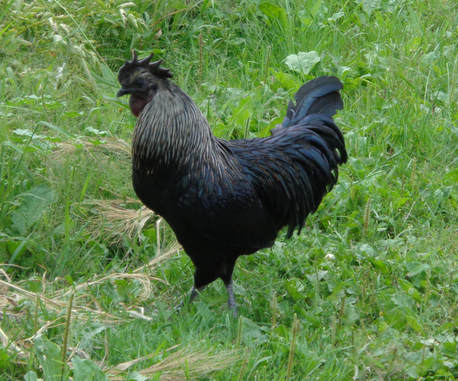
Description: This variety of chicken is a new breed that started its development in the U.S.A.. A few dedicated breeders looking for a Fibromelanistic bird [meaning black skin and comb ] that would lay a colored egg. This breed lays a beautiful green/blue egg. This breed originated in 2004 with Isbars and Svart hona’s being some of the background used in its development. The hen is not broody and lays approx 150 eggs per year. They stand confinement well but love to be high on the roost. They are not a flighty bird and the rooster’s are gentle. The size is 4-5 lbs for roo’s and 3-4 lbs for hens. They come in Black and Blue with silver overtones on the roosters, hens are always a solid color. We have the black.
Extremely rare
Extremely rare
Swedish Flower
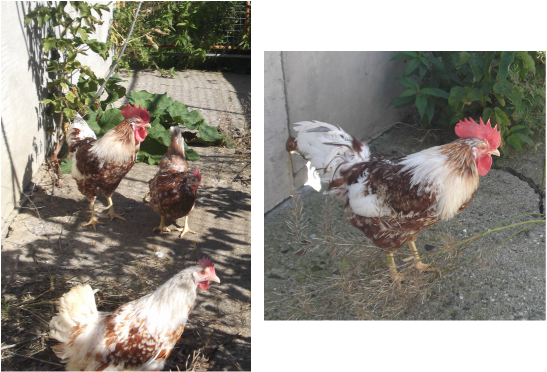
Swedish Flower Hen called: Skansk Blommehona in Swedish which means “ flower hen” is an endangered Swedish breed. They originated in the southern most province of Skane. The breed is over 300 years old. It was first mentioned in a Swedish paper around 1700. The breed was close to extinction in Sweden in the 1970’s when only three flocks remained. These were only found in three Swedish villages. Slowly diligent representatives of the Swedish Country Poultry Club built up the stock again so that the future of the breed is now assured. They were first imported into North America in 2010. There are thought to be around 2000 birds now in existence worldwide. The birds are used for meat and eggs with hens laying approx 200 cream eggs per year. They are healthy and are long lived with a good immune system. About 40% of the hens go broody and make great mom’s. They are very hardy & cope well with cold weather. They are a reasonably heavy breed with hens at 4-5 lbs and roosters at 6lbs. Roosters can be bold but not aggressive. This is a landrace breed meaning no human help in the development of the breed. They can have crests or no crests and come in a diverse range of colors. Some are black and white and some brown, some speckled in brown, black and white. The birds were named Swedish Flower after the white or black flecks “called flowers” on the tips of their feathers which makes one think of a wild flower meadow.
55 Flowery Hen

This breed was created by Pastor Marin Silverudd in Smaland, Sweden. He was finished with the breed in 1955 [ hence the name]. They are an auto-sexing breed, female chicks are barred and male chicks are grayish white/yellow without barring. 55” s are considered a dual purpose breed that lays a large white egg, producing 250-280 eggs per year. They are a large very calm docile breed but active enough to be a good forager and that does well in cold weather. The 55’s have a very good feed to egg conversion ratio. The name “Flowery” refers to the white spot coverage of the hens but for which the roosters are completely missing. The 55’s have a complex mottled {mille fleur} color pattern in the hen’s feather’s, they look strikingly different from the roosters, being mostly white with some color in the hackles. Similar to the Swedish Flower but the colors are more consistent and not as varied. They are the oldest of the Silverudd breeds. They are perfect for the backyard hobbyist. Roosters weigh 6 lbs and hens 4lbs, this makes them a suitable table bird. They are suited to free range or confinement. There are two color varieties Gold and Silver. We carry both beautiful colors running together.



